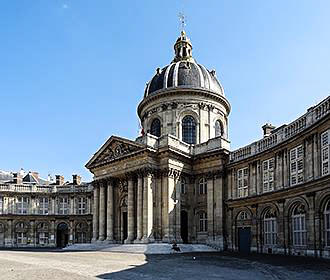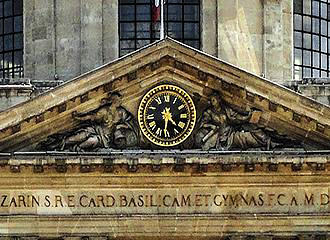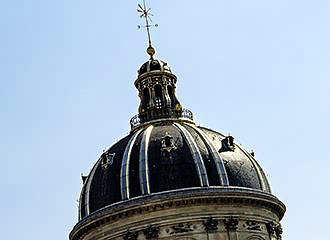Paris Institut de France Historical Monument
Once called the College des Quatre-Nations, the Institut de France was built through a legacy of Cardinal Jules Mazarin and was classified as an historical Paris monument in 1862, and is still home to the oldest public library in France.
About the Paris Institut de France
The Institut de France is sometimes referred to as the Palais de l’Institut, which you may see on different signposts dotted around the city of Paris, and technically, it is like a palace with its beautiful facade, the gilded dome and its decor.
And when you look at the history of the Institut de France, you will find out that this was originally constructed in the 1600s, with an original name of the College des Quatre-Nations, and in a prominent position on the bank of the River Seine facing the Musee du Louvre, this is the largest institution of its kind.
Now, the Paris Institut de France is an organisation that was created by a law decree on the 25th October 1795 and combines five different academies, with the most famous of these being the Academie Francaise that was founded in 1635, with its main task being to protect the French language.
You also have the Academie des inscriptions et belles-lettres, that was founded in 1663 with one of its main duties to produce Latin inscriptions, but today the role is the study of documents, languages and cultures of different civilisations from the Middle Ages, then there is the Academy of Sciences founded in 1666.
An academy of painting and sculpture was founded in 1648, a music academy was first realised in 1669 and an architectural academy was first put in place in 1671, yet these have all been amalgamated into the Academie des Beaux-Arts, which was founded in 1816.
Last but not least, the fifth is the Academy of moral and political sciences, which was put in place at the same time as the Institut de France was organised, however, it was removed in 1803 and restored again in 1832, and still remains one of the five academies today.
You will find that the Paris Institut de France also manages many different historical places in Paris and other parts of France including the Chateau Chantilly, the Musee Jacquemart-Andre museum, the Bibliotheque Mazarin, which is still a public library that is housed within the Palais de l’Institut, the Bibliotheque Thiers and the Musee Marmottan Monet.
Visiting the Paris Institut de France
Unfortunately, the Palais de l'Institut de France is not open to the public, except in exceptional circumstances such as on the second Sunday of each month when groups of up to 30 people maximum, are allowed, provided they are supervised by an official lecturer, and the cost of the speaker is the responsibility of the group. Although, we would like to point out that these visits are not possible during school holidays, and for more information you would need to contact the Institut de France.
However, you may be pleased to know that you can still visit the Bibliotheque Mazarine public library and enjoy the fabulous 17th century decor, along with the busts, period furniture and rare books on display, but the Institut de France does also take part in the European Heritage Days held annually.
The Paris Institut de France and the Bibliotheque Mazarine is very easy to reach, and is hard to miss being such a famous historical Paris landmark with its gilded cupola, not forgetting the fact that it is situated on the left bank of the River Seine opposite the Musee du Louvre museum, with the Pont des Arts, also known as the Bridge of Love going over the water in between the two palaces.
Access to the Paris Institut de France
When it comes to the Paris public transport, with regards to Metro stations, you have the option of the Pont Neuf stop via line 7, the Louvre - Rivoli stop via line 1, the Odeon stop via lines 4 and 10 or the Saint-Michel stop via line 4, which is also an RER train station called the Saint-Michel - Notre-Dame stop for the RER C line.
The Paris bus lines 24, 27, 39 and 95 along with the Noctilien Night Bus Service via lines N12 and N13 stop nearest to the Paris Institut de France and the Bibliotheque Mazarin library at the Pont des Arts Quai de Conti or the Quai Voltaire.
However, on the opposite bank it would be the bus lines 23, 27, 69 and 72 plus the Noctilien lines N11 and N24, or alternatively, a little further along the river by the oldest bridge in Paris called the Pont Neuf you also have the bus lines 21, 74, 75, 76, 81 and 85 plus the Nocilien lines N15 and N16.
Yet the bus tours in Paris such as the Paris Tootbus tours will also get you close by, as will the Batobus, which is the water bus that travels up and down the River Seine with docks at strategic points close to famous tourist attractions.


